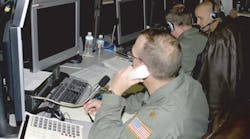by John Rhea
WASHINGTON — Industry experts widely believe that nano-scale devices are the logical successors to today's microelectronics as the electronics industry moves inexorably toward greater miniaturization, speed, and power reduction in information processing devices.
What has been unclear up to this point is whether designers will accomplish this transition to nano technology in a revolutionary fashion, such as the way transistors obsoleted vacuum tubes overnight 50 years ago, or in an evolutionary progression, such as the steady improvements to integrated circuits that continue to this day. Both approaches are proceeding in parallel.
On the revolutionary side, officials of the Clinton Administration have launched what they call the National Nanotechnology Initiative, or NNI, with the fiscal year 2001 budget. The goal is to take a multidisciplinary approach among half a dozen federal agencies in an attempt to create the necessary technology base so that industry can pick up the ball and run with it.
Moreover, experts project funding for this so-called new initiative (presumably to differentiate it from old initiatives) to rise sharply in the coming year's budget: from $270 million this year to $495 million. That's an 83 percent increase. Although half a billion dollars doesn't look impressive within the $1.8 trillion federal budget, it's probably just as well that it's not a conspicuous target for congressional budget-cutters.
The evolutionary approach continues at the U.S. Department of Defense's research arm, the Defense Advanced Research Projects Agency (DARPA), with a core enabling technology known as Microelectromechanical Systems, or MEMS.
This effort within DARPA's Microsystems Technology Office aims at dual-use applications from the beginning. The miniaturized devices that designers are grooming primarily for military sensors are also finding their way into the automobile and information-related industries.
While the two parallel efforts represent significantly different technologies, what they have in common — in addition to their focus on microminiaturization — is a lack of a compelling application to create a groundswell of demand and get the technologies out of the laboratory.
DARPA scientists have had some success using MEMS-based passive sensors for condition-based maintenance on military vehicles, and designers in the commercial trucking industry later picked up this approach, but overall acceptance of MEMS has been slow.
Where nanotechnology can make a major contribution within the coming decade is in creating the next generation of microelectronics devices. The Semiconductor Industry Association (SIA) roadmap projects feature sizes shrinking to 0.1 micron (100 nanometers) by 2010, but that's as far as SIA is willing to predict. That's not even small enough to be considered a true nanostructure.
Using current technology to push feature sizes down to 70 nanometers would mean a single wafer fabrication facility would cost more than $10 billion, according to the report on the NNI issued in February by the Interagency Working Group on Nanoscience, Engineering, and Technology. This report, incidentally, is available on the World Wide Web at Web at http://www.whitehouse.gov/WH/EOP/OSTP/NSTC/html/iwgn/iwgn/fy01budsuppl/toc.htm.
Instead, members of the working group propose new wafer fab processes that would depart radically from today's physics: individual atom and molecule manipulation, batch formation of precursor nanostructures (powder, cluster, colloid, nanowires, and fullerenes), directed self-assembly whereby individual nanostructures aggregate, and parallel processing via arrays of microfabricated materials.
SIA leaders contend that now is the time to get serious about nanotechnology because the lead time for science to mature into technology is at least 10 years. That's already past the end of the current SIA roadmap. The organization identifies four areas where this next generation of microelectronics could have a major impact:
- nanostructured microprocessors to continue the trend toward reducing energy consumption and cost per gate, thereby improving the efficiency of computers by a factor of millions;
- communications systems operating at relatively high transmission frequencies and able to use the optical spectrum more efficiently to provide at least 10 times more bandwidth;
- small mass storage devices with multi-terabit capacities; and
- integrated nanosensor systems capable of gathering huge amounts of data and then processing and transmitting those data from the same miniaturized devices.
All of these applications clearly have dual-use potential, and the military and aerospace industries should be able to reap the benefits.
A closer look at the NNI funding proposed for next year shows that it's heavily skewed toward basic research ($170 million out of the $495 million total plus $140 million for demonstration projects and more than $150 million for facilities). Significantly, the lead agency in terms of funding is the National Science Foundation, up 124 percent from this year's $97 million to $217 million. Next is the DOD with $110 million (up 57 percent from this year's $70 million).
Other participating agencies are the Commerce Department's National Institute of Standards and Technology, $18 million next year; the Department of Energy, $94 million; NASA, $20 million; and the National Institutes of Health, $36 million. About 70 percent of the total is designated for university-based research, which doesn't encourage much industrial participation.
The concept of nanostructures is almost as old as integrated circuits, originating with a 1959 lecture by the premier physicist Richard Feynman, in which he raised the possibility of fabricating devices at the atomic or molecular scale and called them nanostructures.
The idea got a major boost in 1986 with the publication of the book Engines of Creation by K. Eric Drexler, who continues to do missionary work (as well as considerable self-promotion) from his Foresight Institute in Palo Alto, Calif.
As much as Feynman and Drexler were men of vision, many in the electronics industry have been understandably reluctant to embrace an idea that not only would obsolete all their current technology, but also that many within the industry consider to be more science fiction than tomorrow's reality. Of course, the same could have been said — and was said — about Albert Einstein.
Although engineers should always warily view solutions for which no problems are apparent, the investment of half a billion dollars to hedge the nation's bets doesn't appear to be excessive. The working group within the White House is already warning ominously that the Japanese are pushing ahead in this technology and that the Europeans are likely to follow suit.
Congressional leaders appear to be at least open-minded up to this stage, reports the American Institute of Physics (AIP), based in College Park, Md. The group cites U.S. Rep. Nick Smith, R-Mich., chairman of the House Science subcommittee on basic research, as agreeing that "it seems obvious" that the U.S. should "aggressively pursue research in this area." Among the Democrats who have spoken out on behalf of the NNI are Senators Evan Bayh from Indiana and Joseph Lieberman from Connecticut, according to AIP.
Lacking the always desirable "killer application," nanotechnology may yet languish and wither, but in the meantime the participants should enjoy the rare privilege of tweaking the noses of the gods of physics.


